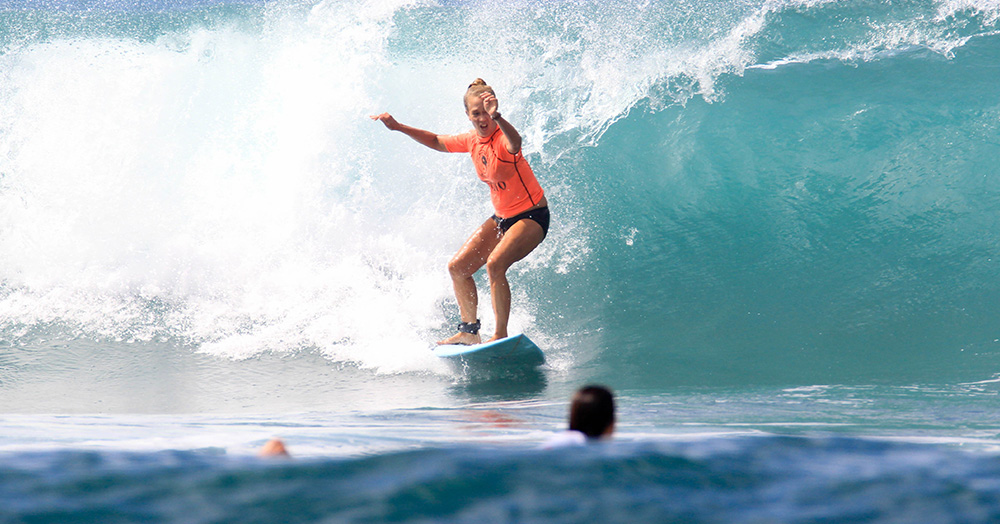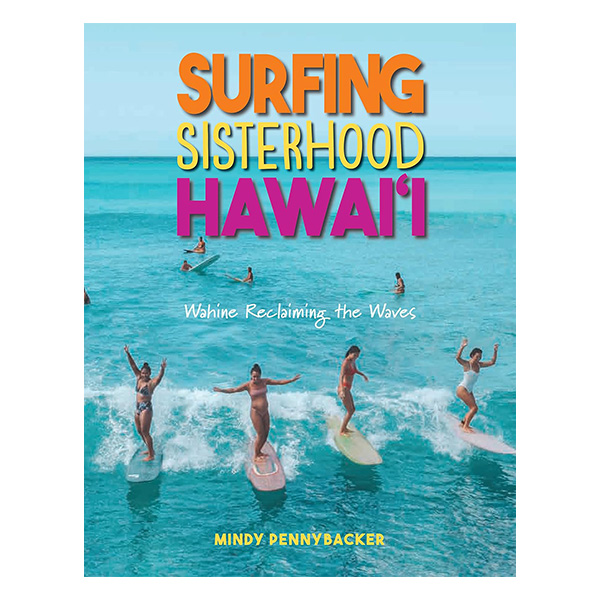Women Have Been Surfing for Centuries
 PHOTO COURTESY MINDY PENNYBACKER
Iowa Writers' Workshop graduate and author Mindy Pennybacker rides a wave in her native Hawaii.
PHOTO COURTESY MINDY PENNYBACKER
Iowa Writers' Workshop graduate and author Mindy Pennybacker rides a wave in her native Hawaii.
When I first started surfing, as a teenager in Honolulu in 1966, my uncle would clear a way for me through the big, intimidating men on long, heavy surfboards—men who vastly outnumbered women in the fabled waves at Queen’s surf break in Waikiki.
Back then, I didn’t see the irony in men dominating a break named for a powerful woman—Queen Lydia Lili‘uokalani, whose cottage had once stood on that very beach. As far as I knew, surfing had always been a man’s sport, one that girls like me were just breaking into. Only later did I learn that women had been surfing since the very beginning, but had been driven out of the sport as it became popular.
In the 19th century, Lili‘uokalani’s own niece Princess Victoria Ka‘iulani famously loved to surf. Long before that, Kelea, a chief of Maui before Europeans first reached the islands, was famous for her surfing, which she had a reputation for loving more than any man. Queen Nāmāhānaʻi Kaleleokalani was “one of the most expert” surfers that the British explorer Peter Puget observed when he traveled to Maui in 1794. “The surf that brought her into the beach was immensely high,” Puget wrote. “On its top she came, floating on a broad board till the break[er] had nearly reached the rocks; she then suddenly turned.” Nāmāhāna’s daughter Ka‘ahumanu was also a surfer, and paddled out with her husband, King Kamehameha I, at the wild cliff breaks of the Big Island’s Kohala coast. “The surfing places were constantly filled with men and women,” the historian John Papa Ī‘ī wrote in 1870. As a boy, he had served in the royal court. Under the Hawaiian kingdom’s traditional kapu system, women could be put to death for eating at the same table as men. But in the surf, men and women had always ridden as equals, on the same waves.
Sometimes the wahine outsurfed the kane. In a contest held in Lahaina in 1887, the favorite, Poepoe, was challenged by his wife, Nakookoo, who shot “like a flying fish through the whitening foam, jostle[d] the champion on his wonted plank of victory, and came in foremost amid the outcries of a delighted multitude glad that the woman had won,” according to a local newspaper at the time.
But generations later, when I started paddling out to my neighborhood break off Diamond Head, I was often the only girl, and the boys blocked me and pushed me off waves, violating all the rules of etiquette that Uncle Shippy had taught me. Worse were the men in their 20s and older who tried to put the moves on me. They would usually back off when I gave them the stink eye and paddled away. But I remember one sunburned tourist who kept paddling after me until I yelled at him to get lost. “Wow,” he responded. “How’d you ever learn to speak such perfect English?” I am hapa, half Asian and half white, but in his eyes I was one of the brown-skinned, darkhaired Native girls who’d been objects of fantasy to outsiders since Europeans first arrived in Hawaii in 1778. Tourists still expected to find us speaking broken English, wearing grass skirts, living in grass huts. But not surfing. Go figure.
The backlash against women surfers took hold in the 1960s, after, ironically, popular books and Hollywood films about a California surfer girl named Gidget had launched the sport as a commercialized lifestyle trend, stoked by the music of the Beach Boys. Men muscled women aside, seizing control of surf contests, magazines, and sponsorship opportunities, and appropriating and revising surf history, stigmatizing women as weaker and less interesting to watch. A seminal 1966 documentary, The Endless Summer, glorified men from California on a round-the-world surf safari while relegating women to supporting positions in bikinis on the beach. California had claimed Hawaii’s endemic sport and narrowed it to exclude women, and was selling it back to us.
“More than 50 years since I first put up with sexist treatment in the water, widespread dismissal, intimidation, bullying, and sexual harassment persist.”
Men’s and women’s contests were held at different breaks. The most prestigious and mediagenic venues, such as the tubing waves at the surf break known as Banzai Pipeline and the giant Waimea Bay—both on Oahu’s North Shore—were deemed off limits to women as too difficult and dangerous. This became a self-fulfilling prophecy, the women’s-surf-event organizer Betty Depolito points out, as women, lacking sponsorships and earning only a fraction of the prize money paid to men, and sometimes none at all, couldn’t afford to travel and invest the time to gain experience at these crowded, contentious breaks. “They say there aren’t enough women, but the reason why is women don’t get the opportunities,” Depolito told me.
More than 50 years since I first put up with sexist treatment in the water, widespread dismissal, intimidation, bullying, and sexual harassment persist. Male surfers outnumber female surfers four to one worldwide, according to the International Surfing Association. In a video that went viral last year, a man drops in on the pro surfer Sara Taylor in Bali; to avoid being hit, she deftly pushes him out of her way and coolly finishes her ride, whereupon a friend of his paddles up and punches her, hard, in the back of the head, driving her underwater.
Yet there is some cause for optimism. In 2017, the World Surf League held its first big-wave contest for women, alongside the men’s, at Maui’s Peahi, the famous break more popularly known as Jaws. In 2019, women’s-surfing advocates pressed the city and county of Honolulu to add gender equity as a criterion in permitting surf events at North Shore beach parks. That same year, the World Surf League began paying equal prize money to both genders. (Until then, men’s-event winners were awarded $100,000, while women were awarded $60,000.) However, Depolito notes, there are berths for only half as many women as men on the championship tour, so more money overall remains available to men.
In 2022, the World Surf League established equal venues, holding a women’s championship-tour contest at Pipeline for the first time ever; at nearby Sunset Beach for the first time in 20 years; and at Teahupo‘o, in Tahiti, for the first time in 16 years. (Still, the women are sent out in inferior conditions, while the best waves are reserved for men.) In January 2023, the sport’s biggest glass ceiling broke when six women surfed (with 34 men) in the Super Bowl of Surfing, the Eddie Aikau Big-Wave Invitational at Waimea Bay. But another event, Depolito’s Women of the Bay contest at Waimea, has still never been held, because the Eddie permit claims the three-month winter window for waves of sufficient size, coinciding with the time of year when monster surf rolls up to Oahu’s North Shore.
“Having some 100 percent women’s surfer events will get more women surfing, which is a good thing,” the city’s parks director, Laura Thielen, said in one public meeting. (After some men protested the notion of women-only competitions, Thielen quoted Justice Ruth Bader Ginsburg’s reply, upon being asked when there would be enough women on the Supreme Court: “When there are nine.”)
“Our offshore-surf lineups are a microcosm of a society in which women still have to fight to be taken seriously far too often.”
This summer, I will be rooting for Honolulu’s hometown hero, Carissa Kainani Moore, a five-time world champion who will surf on the U.S. team in the 2024 Paris Summer Olympic Games, at Teauhupo‘o, Tahiti. Moore won the women’s gold medal in the first Olympic surfing event, in 2021. For more than a decade, she and her generation have led a resurgence in women’s surfing, riding in the wake of pioneers who have been fighting for equality for more than 60 years. But there’s still a long way to go. As many surfers have told me, our offshore-surf lineups are a microcosm of a society in which women still have to fight to be taken seriously far too often.
“Go on any wave,” a fellow surfer told me the other day, but when I paddled for a nice one, he couldn’t help himself—he cut me off.
This essay was adapted from the book Surfing Sisterhood Hawai’i: Wahine Reclaiming the Waves (Mutual Publishing, 2023) and was originally published in The Atlantic (theatlantic.com) on Sept. 6, 2023.
 PHOTO COURTESY MINDY PENNYBACKER
PHOTO COURTESY MINDY PENNYBACKER
Mindy Pennybacker (77MFA) is a Hawaii native and surfing columnist for the Honolulu Star-Advertiser. A graduate of Stanford University, University of Iowa Writers’ Workshop, and University of California at Davis’ Martin Luther King School of Law, Pennybacker is also author of Do One Green Thing: Saving the Earth Through Simple, Everyday Choices (St. Martin’s, 2010). Her stories and articles have appeared in The Atlantic, The New York Times, The Wall Street Journal, The Nation, Sierra Magazine, and The Surfer’s Journal.

